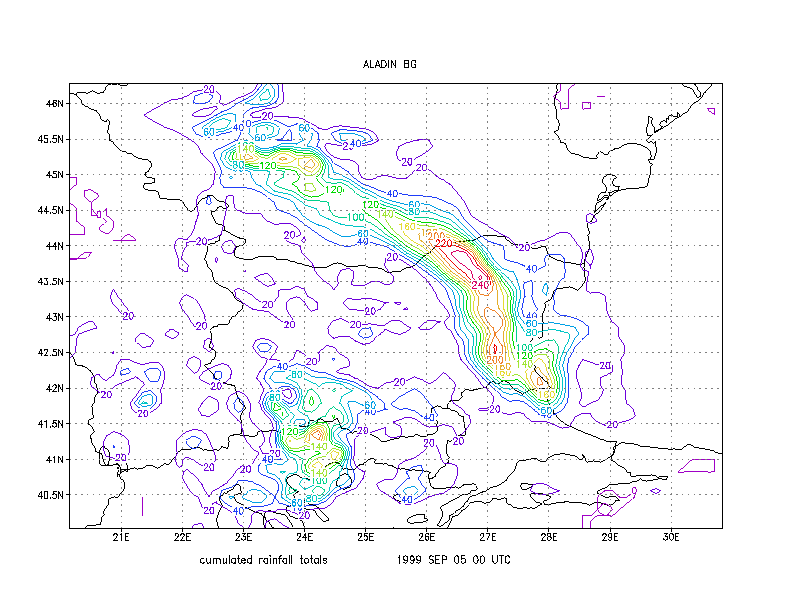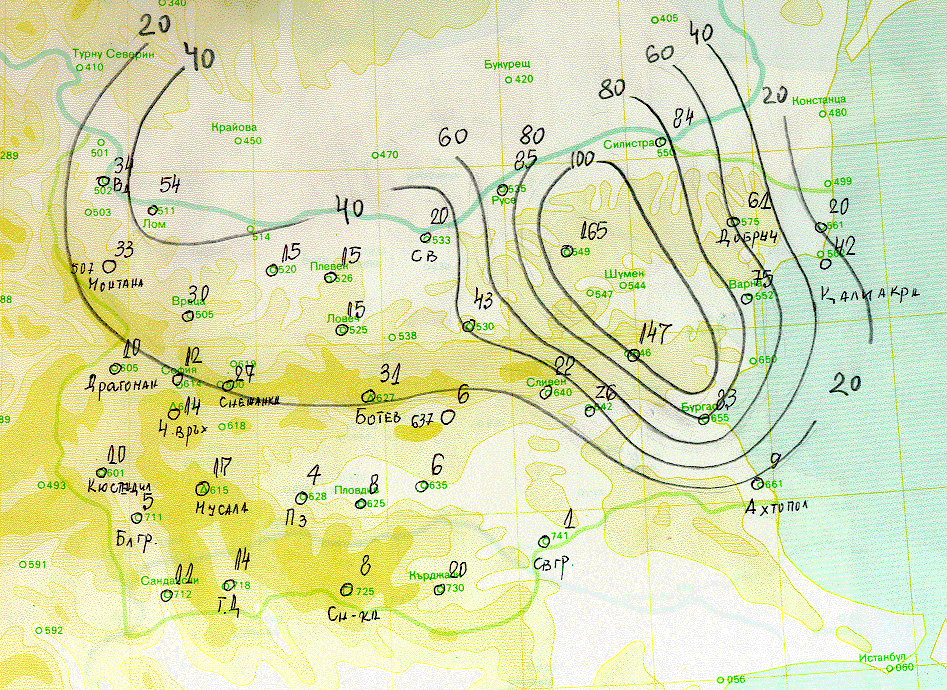See updated informations on this web server at: http://www.cnrm.meteo.fr/aladin/oper/oper.html.
 more details
jure.jerrman++at++rzs-hm.si)
more details
jure.jerrman++at++rzs-hm.si)
During the phasing of ALADIN 12 some efforts were also made to provide a more workstation friendly code. It is known fact that Fujitsu compiler comparing to workstations compilers is more tolerant which means that quite a lot of routines don't compile on workstations (in ALADIN 11T2 there were more than 80 such as routines on DEC workstation) in the first try. The errors are usually very simple like multiple declarations of variables in USE MODULE block, declaration of array with dimension declared later on in declaration part, etc. In order to decrease the time needed for installation of new versions of ALADIN on workstation the routines with such as problems were fixed (on the base of problems list for True64 - former DEC compiler). Hopefully the modifications will enter the next export version of ALADIN 12.
It was decided that such cleanings should be done on regular basis. All users of workstation version of ALADIN are kindly invited to report their problems to ALABOBO list (alabobo++at++meteo.fr) and if the required modifications will not be too complicated, they will be introduced in the next export version.
In the last time, no changes were introduced in ALADIN/Vienna, but there are some undergoing actions, e.g. coupling the trajectory model of our environmental department with ALADIN/Vienna, a new GUI (Graphic User Interface) tool and a verification tool.
Operational suite
These last 3 months have essentially been devoted to the reorganization of the operationnel account ALADIN prevision Belgium.
1) An increase in operational reliability by the introduction of many additional securites throughout the scripts chain.
2) Larger facilities of management of the account, thanks to the assistance of a global control script. This one allows amongst other things:
- A simplified management of the cron for the daily forecasts.
- An easy restart of jobs following a problem.
- To visualize in reel time and details all the tasks to be done by the operationnal forecasts and restarts.
- Virtually all the operations done within the scripts are coupled by a function which generate a specific code, dependent on the operation and successes of this one. The whole of these codes is then interpreted continuously by an additional script, to produce a report in the form of a text.
- To realize an automatic restart, partial or complete of jobs, according to the error codes possibly encountered.
Operational developments
Upgrading to 8 more powerfull processors entrained a considerable gain on runtime.
AL11 with new tunings and compiled on the new processors runs about 2 times faster then AL09 compiled on the old processors. This lead us to integrate the youngest physical developments (CYCORA), including the downdraught parameterization, in the operational forecast.
Example: respective performances for the forecast run (analysis 1 Oct 1999 at 00 UTC):
- AL09 operational: 9350 sCPU, 2050s Wallclock for a 48h forecast
- AL11 standard : 3660 sCPU, 674s Wallclock for a 36h forecast
- AL11 CYCORA : 3790 sCPU, 747s Wallclock for a 36h forecast
Please also note that the runtime of a timestep is more dependent on the atmospheric situation when the downdraught parameterization is enabled.
AL11: operational in Belgium since 4 Oct 1999.
Implementation of the CRAY version and feedback to Toulouse of the main fixes and source corrections, which were subsequently included in version AL11T2/CY21T2.
Double chain tests were completed with conventional and CYCORA tunings. We decided to include them soon into the operational chain (substraction of large scale precipitation from moisture convergence feeding the convective scheme, accounting for pressure gradients between cloud and environment, CAPE dependency for entrainment, cloud mass flux dependency for detrainment, downdraught parameterization,...). We saw no spectacular differences, but for this we should better choose specific situations, and the small gain in resolution between the coupling model Aladin-France (9.9 Km) and the coupled model Aladin Belgium (6.97 Km) could also justify the low impact. Further mesh reduction, with possible introduction of the non-hydrostatic model shoud now be studied.
Tests for MPI compilation: following some bugs in CRAY f90 (conflicts
between module usage and data passing in ``taskcommon'') for which the
solution was awaited very long, some unacceptable conditions imposed by SGI to
provide a cc compiler version suitable for MPI compilation (they want to sell
the full C++ package), the tests were halted with no deadline.
Since 15 of May, ALADIN/bulgaria application became operational. The 48 hours forecast was calculating every night, using the 12-h ARPEGE forecast from 12 UTC as initial condition. Since The 15 of June, the 48 hours forecast was calculated twice per day using the 12 -h ARPEGE forecast from 12 and 00 UTC.
The model is running on work station SUN Ultra Sparc 60 with following configuration:
- Processor clock rate 360 MHz
- Memory - 256 MB;
- Disk storage ~ 50 GB
- Operational system - SOLARIS 2.7
- Compilers - FUJITSU FORTRAN 4.1 professional and corresponding C++ compiler as well as other tools (work bench, debugger, visual analyzer, math libraries)
- Geometry: &NAMFPD
NLAT=72,
NLON=90,
RLATN(1)=46.40865,
RLATS(1)=39.79419,
RLONW(1)=20.01355,
RLONE(1)=31.63768,
NFPLUX=79,
NFPGUX=63,
NFPZONL=8,
NFPZONG=8, - Geometry: &NAMFPG
FPRPK=.707107,
FPLON0=25.0,
FPLAT0=45.0,
NFPSOTRP=1,
The computation flow is driven by two basic scripts. The first one is responsible for the proper connection with the PICKUP-s, properly asking questions, analyses of the answers and finally for transferring and checking the consistency of the files with the initial and boundary conditions. One important action of this script is that if the connection is not possible using the default Internet provider, it tries using the second one. In any case it works properly.
The second script is responsible for all activities, related with ee927, integration, off-line post processing, visualization and creating a specific files for the end users. This one first of all checks if all necessary information is available. If not, the script sleeps 10 minutes and after that, it repeats the check. This action can be satisfied in two ways: the first - all information is available and the procedure can go on, and the second on given time out the procedure exits without creating any products, writing only the log files.
If the information check is successful the procedure continues with the change of the geometry, integration, of-line post processing, visualization and creating a file for end users. The result of every step is analyzed by the script. If there would occur return code different from normal one, the procedure will stop making the corresponding records in the log files. The performance of the first script depends on a speed of an Internet link. The second one depends on the work station load. Usually the are no active users (I mean users making heavy computations) during the run of the operational script. All this computations were done for ~ two hours.
The visualization tool is GRADS (Grid Analyses and Display System). All images of the forecasted fields at first step are saved as GRADS meta files and finally as GIF files. All forecasted fields from today and yesterday forecasts are available for displaying on Intranet server of our department. There is an additional possibility for movies using the ACDSee 32 program.
An example of a forecast of a heavy precipitation over east Bulgaria is given at the previous page.
If the information check is successful the procedure continues with the change of the geometry, integration, of-line post processing, visualization and creating a file for end users. The result of every step is analyzed by the script. If there would occur return code different from normal one, the procedure will stop making the corresponding records in the log files. The performance of the first script depends on a speed of an Internet link. The second one depends on the work station load. Usually the are no active users (I mean users making heavy computations) during the run of the operational script. All this computations were done for ~ two hours.
The visualization tool is GRADS (Grid Analyses and Display System). All images of the forecasted fields at first step are saved as GRADS meta files and finally as GIF files. All forecasted fields from today and yesterday forecasts are available for displaying on Intranet server of our department. There is an additional possibility for movies using the ACDSee 32 program.
Here is an example of a forecast of a heavy precipitation over east Bulgaria.


Since March 1999 the maximum forecast range of Aladin-France is 48 hours for 00 H basis (still 36 hours for 12 hours basis) and forecasters in each center will soon be able to visualize the forecast between 36 and 48 hours.
On the workstation SUN, with the compilator F90 fujitsu, the ALADIN version ( al11_main.01 + cy21t1_main.01 with bugfix al11_bf.04,cy21t1_bf.04 ) has been implemented. As usual, some tests for the configuations 001 and Fpos, have been made on the French domain with comparison with VPP Fujitsi .
The xrd library of the export version export_AL11T2_01 has been put on SUN plaform, and tests have been made with the tool progrid to validate it.
This version export_AL11T2_01 is going to be implemented.
There was less activity during the last quarter regarding the workstation version of ALADIN due to the summer holidays and also due to the fact that Gabor Radnoti was working in Prague and Andras Horanyi had been in Toulouse during the month of July.
Nevertheless the following activities were carried out during this period:
1. The adaptation of AL11t1 version of the ALADIN code (it was not yet put into operations).
2. Test runs for the eclipse of 11th of August.
3. Further development of diag.pack in a two weeks team work by Vincent Casse, Jure Jerman and Gabor Radnoti (the summary of their work can be found elsewhere in this Newsletter).
4. Automatic forecast generation based on the products of the ALADIN/HU
model.
Evolution of the ALADIN/LACE application.
The main change in the ALADIN/LACE operational configuration occurred on 9th August 1999, 12 UTC run, when it moved from cycle AL09 with LFGELS bugfix to AL11 with eclipse bugfix. The change allowed to simulate the solar eclipse effect on the show-wave solar radiation flux in the forecasts valid for 11 August.
The switch to the new settings of the convection parameterisation as the result of the CYCORA tuning is scheduled to the end of November.
Parallel Tests
In parallel with the regular operations the following tests are run to assess impacts of various modifications. The main test in the reported period were:
1) Family of parallel tests in frame of the CYCORA action. The most remarkable impact was seen in the test when the operational version of ALADIN/LACE (therefore without CYCORA settings) was fed by the coupling files originating from the parallel test of ARPEGE with CYCORA settings. The CYCORA impact on ALADIN itself remained neutral (because of the continental character of the domain ?).
2) Validation of AL11 with eclipse bugfix giving no significant change in the scores compared to the operational version. More detailed information on the parallel tests of ALADIN/LACE can be found at: www.chmi.cz/meteo/ov/lace/aladin_lace/partests/
Research & Development
The ALADIN model is running in Morocco with ISBA assimilation cycle twice a day with 16,5 km resolution, 675s time step and 31 levels. The model version is still based on cycle AL08 (the problem for compilation of the xrd library still remains). The operational suite of ALADIN uses data from the local Moroccan "Base de Données Météorologiques" (works about the portage of the BDM on workstation is finished).
For Model control and monitoring, an operational system of control has been installed and a three monthly review of control of ALADIN on Morocco area is quarterly published.
For model development, some studies about statistic balance of the forecast error for the 3D-Var on Morocco area have been done and the characterization of the Meteorological situation using ALADIN (or ARPEGE) analysis has been performed. Efforts are still focused on the improvement of the forecast of the precipitation field and on the implementation of a system of regional forecast using nested model.
The opportunity to shift operational computations from IBM RS/6000 SP2 to new machine, namely SGI Origin-2000, has emerged. Version AL09 of the Aladin model was installed and test runs were carried out. The change of computer is accompanied by change of the model configuration. New domain will cover 2270~km~x~2270~km area instead of 1040~km~x~1040~km covered by currently being applied.
New operational setup:
- machine:
SGI Origin-2000, 32 x R10000 250 MHz CPU's,
16 GB RAM, 36 GB HDD, OS IRIX 6.5 - model version: AL11
- mesh size: 169x169x31 ( C + I )
- resolution: 13.5 km
(more details mario.almeida++at++meteo.pt )
ALADIN is still pre-operational. Until the end of August, misses of the runs were due to problems with the settings of our local configuration, line/router problems and unavailability of LBC fields in Toulouse.
We are still running version Al08, but tests with version 09 are almost finished and soon will be introduced into a new WorkStation. Later on, a redefinition of the geographical area and mesh size is planned.
About the operational ALADIN (cycle 9) in Bucharest:
- Hardware and software platform
-DEC ALPHA Station, 600 MHz, 256 MB
-Digital UNIX 4.0D, FORTRAN 90 - Integration domain
-100x100x31 points
-10.2 km horizontal resolution - Characteristic
-twice per day integration in dynamical adaptation model
-2 tl semilagrangean scheme with 540 seconds timestep
-48 hours forecast range
-integration time 2.0 hours - Model output verification
-Objective verification against SYNOP and TEMP data
-Subjective verification - Visualisation of numerical output
-MESSIR-VISION system
-NCAR Graphics
-VIS 5D - Interface to
-air pollutant transport and diffusion models (MEDIA and others)
-hydrological models
-Wave model over Black Sea
About research and development ALADIN activity
- High resolution model experiences
-non-hydrostatic integration over subdomains of Romania
-use oh high resolution surface data from LANDSAT-TN satellite(100m resolution) over Bucharest - Statistical adaptation of ALADIN output
-temperature for all National Network surface stations
- Study and development of physical
parameterisation (convection)
Main events during 1999:
- In March 1999 DEC Alpha WS was upgraded considerably. Model was successfully ported on this upgraded computer and after a short testing and validation period ALADIN/SLOK became fully operational in April 1999. By that time model products are available on-line at the Central Forecasting Office (CFO).
- In May 1999 a new model version was implemented (release AL09 + CY19T1, export 07), which - among others - enabled to use new surface parametrization (surface frozen water reservoir). This new version became operational - in coordination with all ALADIN operational applications - on 26/05/1999.
- During summer, two new products from ALADIN/SLOK were prepared: meteograms for 22 cities in Slovakia and renewed/modified version of the diagnostic tool for plotting vertical cross sections over the model domain (ASCS tool). All products are available at CFO.
- New cycle CY21T2/AL11T2 was implemented and tested, but it's not in operational yet.
Basic characteristics of the workstation:
- DEC Alpha XP1000, 640 MB of memory, 12 GB HDD
- Digital F90 compiler; native C compiler
Basic characteristics of ALADIN/SLOVAKIA:
- size of the domain 79x53 grid points
- horizontal resolution 7.18 km
- vertical resolution 31 levels
- time step 337.5 s
- length of the forecast 48 hours
- frequency of the outputs 1 hour
- runs: twice per day (00 UTC and 12 UTC)
- mode dynamical adaptation
- coupling model ALADIN/LACE (12.2 km resolution)
- physics and dynamics the same as ALADIN/LACE
Operational configurations:
- ee927 preparation of initial and lateral boundary condition
- e001 model forecast postprocessing (into model levels and standard pressure levels)
- FULL-POS
Main products:
- surface parameters in map form (2m T, 2m Tmax, 2m Tmin, 2m relative humidity,10m wind, precipitation, cloudiness)
- meteograms for 22 cities over Slovakia
- input for ASCS tool (explained in visualization part)
Recent developments in the operational suite of ALADIN/SI
The operational suite of ALADIN at the HMIS was based on AL08, with two daily runs for 48 hours ahead, coupled with ALADIN/LACE on the usual domain.
The operational production includes surface and p-levels 2D charts, point forecasts, areal precipitation forecasts, space cross sections, pseudo-temps and dynamic adaptation of surface wind.
However, on November 24, after two weeks of observation, the operational suite was moved on the cluster of 5 workstations (w. 533 MHz Alpha processor, please refer to J. Jerman's contribution in previous newsletters for all details).
AL11 is used. Accordingly the schedule was modified:
- ee927 is done immediately when an ALADIN/LACE file arrives, on father workstation (pannus0)
- after the second coupling file arrives, the integration starts on 4 baby stations (pannus1 - pannus4)
- drawing of the fields is done simultaneously on pannus0
- after the integration ends, one baby station computes the space cross-sections, while the three others perform the dynamic adaptation of surface wind
- meanwhile, point forecasts are made on father station.
- This schedule is still tied by the speed of transfer of boundary conditions.
In near future the change of resolution will be investigated, enabled by some free resources. We will not switch to NH version in envisageable time.
